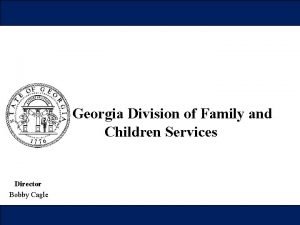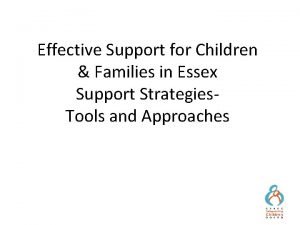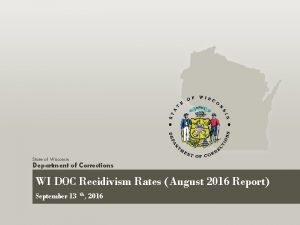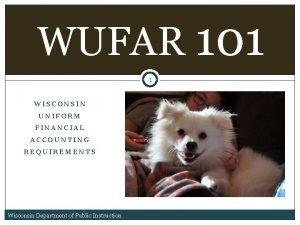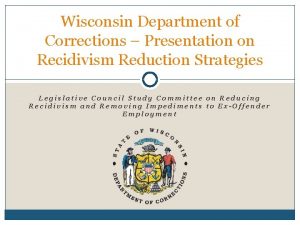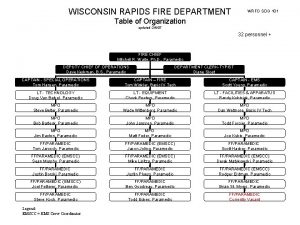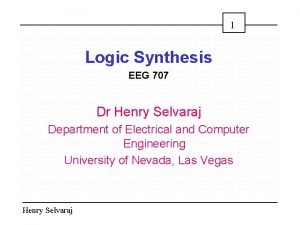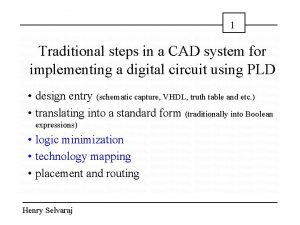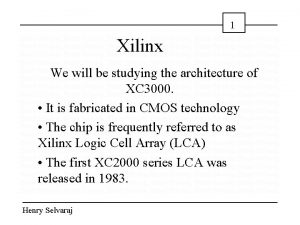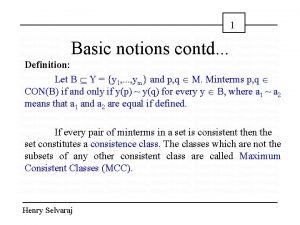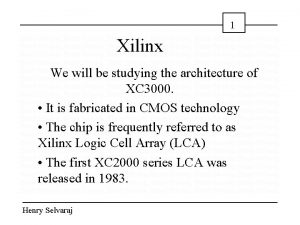Wisconsin Department of Children and Families Henry Wilde











- Slides: 11

Wisconsin Department of Children and Families Henry Wilde, Deputy Secretary 1. 2. 3. 4. 5. Wisconsin Shares background Nature of Wisconsin Shares fraud What we have done Results Lessons learned 1

Wisconsin Shares Background Unfettered Growth, Little Oversight Direct Expenditures to Programs (mm$) • Wisconsin Shares has tripled in size over 10 year period • Over budget 5 consecutive fiscal years • 8 staff overseeing nearly $400 mm program • Two state agencies + Counties + W-2 Agencies touching child care facilities 2

Nature of Wisconsin Shares Fraud What did we find? • • No incentives to monitor costs anywhere in the entire system – State always picked up bill – Counties and W-2 agencies – Providers – Parents Lack of coordination between state agencies responsible for regulating different facets of the same facilities No ability to independently verify attendance Minimal legal ability to take action when fraud was detected Minimal law enforcement resources dedicated to the issue No use of data to identify anomalous (or impossible) patterns of provider behavior Gross failure in Milwaukee County, location for 59% of payments 3

Nature of Wisconsin Shares Fraud Data examples • • Examples of quantitative red flags: – 87 providers were receiving more than $15, 000 per licensed slot – all 87 in MKE County – 93 providers claimed to be serving an average of greater than 2. 5 Shares children per slot – 90/93 in MKE County – 36 providers claimed to be serving greater than an average of 3 Shares children per slot – all 36 in MKE County Three cases identified with data: – 223 Shares authorizations, licensed capacity of 90 – and 212 were children of “employees” – $35, 323/licensed slot and 5. 38 children/slot – $28, 883/licensed slot and 3. 75 children/slot in one facility; $27, 764 and 4. 50 in a second owned by same person 4

Nature of Wisconsin Shares Fraud Real life examples • • • Suspended provider who walked across the street and offered to sell 25 authorizations to provider for $1, 500 every two weeks. Call from a center’s one real employee, who called to ask why we had not shut her place of employment down yet and shared the names of 10 fake employees. Multiple providers who claim full second and third shifts despite surveillance indicating zero attendance for weeks Suspended provider whose exemployees went looking for employment at child care facilities, under the condition that they do not have to work. Suspended provider who actively recruited large immigrant families at W-2 agencies to participate in scheme 5

Nature of Wisconsin Shares Fraud General Categories of Child Care Fraud 1. 2. 3. 4. 5. 6. Children not attending – attendance records fictionalized or embellished Parents listed as employees of child care centers to get Shares benefit – child nor parent never actually attend Second and third shifts that do not exist Child attendance used as jigsaw puzzle pieces – child simply unit to be monetized Larger defrauders learned system as a family provider and expanded to group Friends and family connections, but no centralized organized crime racket 6

What We Have Done • • • Combined licensing and subsidy and incorporated subsidy monitoring into standard procedures Mined data – and used it to guide and prioritize Staffed up – Fraud Detection and Investigation Unit, licensors, attorneys Created three Child Care Anti-Fraud Task Forces including DA, FBI, DOJ, IRS, DOR, Sheriff, MPD, US Attorney Received permission, funding for Automated Attendance Strengthened laws: – Ability to stop payments – Background checks – Automated authorization adjustments – 60% non-employee children 7

Results $100 mm in Savings Over Biennium The state has realized over $100 million in anticipated savings without significantly limiting access to families: Less children Less hours authorized Less hours attended for “attendance-based children” Less “enrollment-based authorizations” 8

Wisconsin Shares Enrollment Trends 9

Wisconsin Shares Payment Trends 10

Lessons and Issues Lessons 1. 2. 3. 4. 5. 6. Issues Siloed programs and information don’t just impede access – they facilitate fraud. Use data and technology to eliminate obvious stupidity. Understand the incentives of the actors involved in the system (and the implications). The child care voucher market does not function properly without suitable intervention – payment needs to be linked to quality. Media makes a tremendous difference. Fighting fraud is a huge financial opportunity -- and NOT fighting fraud is a huge risk. 1. Hard to catch and then hard to punish – fraud needs to be stopped up front 2. Perceived profiling 3. Due process 4. Provider as beneficiaries versus businesses 5. Pandora’s Box 6. Implementation risks 11
 Georgia department of children and families
Georgia department of children and families Little families
Little families Effective support for children and families in essex
Effective support for children and families in essex Wi doc
Wi doc Wufar codes
Wufar codes Heather bruemmer wisconsin
Heather bruemmer wisconsin Wisconsin department
Wisconsin department Wisconsin department
Wisconsin department Wisconsin rapids fire department
Wisconsin rapids fire department The canterville ghost characters images
The canterville ghost characters images Satire in pygmalion
Satire in pygmalion One act iscar wilde play
One act iscar wilde play
